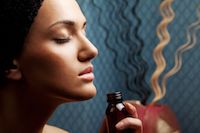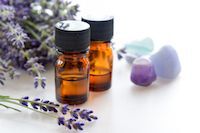
What is Aromatherapy?
Aromatherapy uses essential oils from plants for healing. The oils can be inhaled. They can also be rubbed into the skin. They are rarely taken in by mouth.
What are essential oils?
Essential oils are from the roots, leaves, seeds, or blossoms of plants. Each essential oil contains its own mix of active ingredients. The mix determines what it is used for. Some oils are used for physical healing. Others are used for emotional healing.
What is aromatherapy good for?
A health professional may use aromatherapy to help you. You also can use it to take better care of yourself. Essential oils could help with pain, mood, and relaxation. Different people like different spells. If you don’t like the smell an oil, try a different one.
| Condition | Essential Oils |
|---|---|
| Agitation, possibly including agitation related to dementia | Lavender and orange, used along with massage |
| Anxiety | Various mixes: bergamot, cedarwood and lavender; lavender only; orange and lavender; lavender and rosemary |
| Constipation | Lemon, peppermint and rosemary (with abdominal massage) |
| Depression | Bergamot, geranium, jasmine, lavender, lemon, rose. Note: Most studies looked at the use of essential oils and massage together. |
| Sleep disorders | Lavender, cypress, chamomile |
| Nausea, Vomiting | Ginger oil |
| Pain | Some studies suggest that people with rheumatoid arthritis, cancer (using topical chamomile), and headaches (using topical peppermint) require fewer pain medications when they use aromatherapy |
| Itching, a common side effect for those receiving dialysis | Lavender, mint, and tea tree oils |
| Premenstrual syndrome and menopause | Neroli, ylang ylang, or clary sage with massage onto abdomen or geranium, juniper, evening primrose oil, and/or vitamin E oil for breast tenderness (PMS); clary sage, fennel, and geranium (Menopausal symptoms) |
Are there any side effects or risks?
Most essential oils are safe when inhaled or used on the skin. It can be dangerous to take essential oils by mouth. You must work with a trained professional and your primary healthcare provider if you are going to do this.
How are essential oils used?

Essential oils may be used as part of a massage or they can be used on their own. You can breathe in essential oils directly from a piece of cloth. You can breathe them in indirectly through steam inhalations, vaporizers, or sprays. Essential oils can also be applied to your skin. Only specially trained professionals can provide treatment that involves taking essential oils by mouth.
Who should be cautious about using essential oils?

- Pregnant women
- People with asthma
- People with a history of allergies
- People taking medication
Talk to your primary healthcare provider before using essential oils. In these cases, you should only use essential oils when working with a trained professional.
Print Version
References/Resources
Additional Information
National Center for Complementary and Integrative Health
University of Maryland Medical Center
References
Atsumi T, Tonosaki K. Smelling lavender and rosemary increases free radical scavenging activity and decreases cortisol level in saliva. Psychiatry Res.
Ballard CG, Gauthier S, Cummings JL, Brodaty H, Grossberg GT, Robert P, Lyketsos CG. Management of agitation and aggression associated with Alzheimer disease. Nat Rev Neurol. 2009 May;5(5):245-55. Review.
Edris AE. Pharmaceutical and therapeutic potentials of essential oils and their individual volatile constituents: a review. Phytother Res. 2007;21(4):308-23.
Fellowes D, Barnes K, Wilkinson S. Aromatherapy and massage for symptom relief in patients with cancer. Cochrane Database Syst Rev. 2004;(2):CD002287.
Hur MH, Song JA, Lee J, Lee MS. Aromatherapy for stress reduction in healthy adults: A systematic review and meta-analysis of randomized clinical trials. Maturitas. 2014;79(4):362-369.
Hwang E, Shin S. The effects of aromatherapy on sleep improvement: A systematic literature review and meta-analysis. J Altern Complement Med. 2015;21(2):61-68.
Herz RS. Aromatherapy facts and fictions: a scientific analysis of olfactory effects on mood, physiology and behavior. Int J Neurosci. 2009;119(2):263-90. Review.
Kim MA, Sakong JK, Kim EJ, Kim EH, Kim EH. Effect of aromatherapy massage for the relief of constipation in the elderly. Taehan Kanho Hakhoe Chi. 2005;35(1):56-64.
Kuriyama H, Watanabe S, Nakaya T, et al., Immunological and Psychological Benefits of Aromatherapy Massage. Evid Based Complement Alternat Med. 2005;2(2):179-184.
Lee YL, Wu Y, Tsang HW, Leung AY, Cheung WM. A systematic review on the anxiolytic effects of aromatherapy in people with anxiety symptoms. J Altern Complement Med. 2011;17(2):101-108.
Lee YR, Shin HS. Effectiveness of ginger essential oil on postoperative nausea and vomiting in abdominal surgery patients. J Altern Complement Med. 2016.
Lin PW, Chan WC, Ng BF, Lam LC. Efficacy of aromatherapy (Lavandula angustifolia ) as an intervention for agitated behaviours in Chinese older persons with dementia: a cross-over randomized trial. Int J Geriatr Psychiatry. 2007;22(5):405-10.
Maggio A, Rosselli S, Bruno M. Essential oils and pure volatile compounds as potential drugs in alzheimer's disease therapy: An updated review of the literature. Curr Pharm Des. 2016;22(26):4011-4027.
Mercier D, Knevitt A. Using topical aromatherapy for the management of fungating wounds in a palliative care unit. J Wound Care. 2005;14(10):497-8, 500-1.
Shahgholian N, Dehghan M, Mortazavi M, Gholami F, Valiani M. Effect of aromatherapy on pruritus relief in hemodialysis patients. Iran J Nurs Midwifery Res. 2010;15(4):240-244.
Tillett J, Ames D. The uses of aromatherapy in women's health. J Perinat Neonatal Nurs.2010;24(3):238-45.
Yang YP, Wang CJ, Wang JJ. Effect of aromatherapy massage on agitation and depressive mood in individuals with dementia. J Gerontol Nurs. 2016;42(9):38-46.
Yim VW, Ng AK, Tsang HW, Leung AY. A review on the effects of aromatherapy for patients with depressive symptoms. J Altern Complement Med. 2009;15(2):187-195.
Patient Education Materials
- Acupuncture
- ADHD
- Allergic Rhinitis
- Anxiety
- Asthma
- Autism
- Back Pain
- Biofeedback Therapy/Training
- Breathing Techniques
- Cancer Symptoms
- Chiropractic
- Constipation
- Depression
- Diabetes
- Dyslipidemia
- Eczema
- Elimination Diet
- Fibromyalgia
- GERD
- Headache
- Healthy Diet
- Healthy Weight / Obesity
- Heart Disease
- High Blood Pressure
- Inflammatory Bowel Disease
- Insomnia
- Irritable Bowel Syndrome (IBS)
- Massage Therapy
- Meditation
- Menopause
- Menstrual Disorders
- Osteoarthritis
- Physical Activity
- Probiotics
- Progressive Muscle Relaxation
- Rheumatoid Arthritis
- Supplements
- Tai Chi
- Yoga